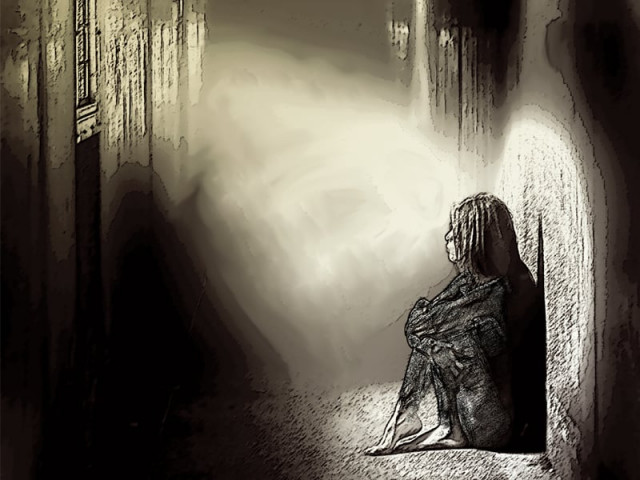Does the caged bird sing?
For women in this jail, captivity is full of contradictions.

“Yoga is about the liberation of the soul, and freedom from certain thoughts,” says Chapra. “Obviously it touches different people in different ways, but in the specific context of prisoners — since most of these women have had experiences with violence — it helps them be grounded in the present moment.”
The Karachi women’s prison is inhabited by women who are accused of theft, trading narcotics, murder and other crimes. Out of the 68 inmates in the prison only 20 have stood trial and been convicted and the rest do not know what the future has in store for them.
For them, regular activities like yoga are a much-needed distraction from the banality of life in prison.
“Initially we only used simple concepts: watching yourself, stretching, listening to different sounds around you, stopping the mind from constantly thinking about the past or the future. The students only began to use yoga as a way to forge a deeper connection with their own psyche in the last two or three months,” she says.
She says that students have given her positive feedback about her yoga lessons, but refuses to tell me any more. “I prefer not to indulge in the details,” she says. “I’ll be creating a divide between me and them by talking about them in that way, and one of the things that yoga brings about is unity: during yoga we feel like one big body breathing together, it’s this beautiful feeling of oneness.” Speaking of divides, sitting in an air-conditioned café breathing in the aroma of freshly brewed coffee while discussing the problems of incarcerated women seems like an easy way out for me. Clearly, a visit to the prison is in order.
When I speak to the prison’s matron, Abida, on the phone, she tells me: “Activities like yoga keep the prisoners busy and reduce fights between the women. Also, since they are learning something new — they can then teach it to their kids,” she says. Mothers who have children under the age of eight can opt to bring them along to prison if there is no one to take care of them at home. So not only are some inmates trying to keep their own spirits up, they are trying to raise children in confinement too.
When I prepare myself to visit the prison, I am all geared up to speak to the inmates, but the words of an NGO worker echoe in my head. Fehmida, a representative of the Society for Human Rights and Prisoner’s aid (SHARP), has worked with prisoners at the women’s jail before, and when I called her for advice she said the prisoners I would meet would be anything but forthcoming. “It’s unlikely that they will tell you anything because to them you are an outsider. But you will see that for many, the prison is a safe haven as the world outside is not very welcoming to them.”
When I arrive at the prison, I am pleasantly surprised by the cleanliness of the place and the well-maintained facilities. Addi, the prison officer who becomes my tour guide and has been working in the prison for 24 long years, says: “This place is like a mother’s womb for the inmates. They cannot move around, but at least they are safe — safer than anywhere else.”
This is a unique way of looking at confinement, for sure. Apart from weekly visits from doctors and basic literacy lessons, activities like stitching and yoga must be a good way to keep busy, I muse. The classes at the prison, be it Quran classes, computer lessons, English, Math, yoga or stitching are all voluntary. What each inmate opts for is a personal choice. The bad news is that not all inmates are as enthusiastic as others, but who am I to judge, I think to myself, as I see a few inmates simply lying on their beds, staring listlessly at the ceiling fans. The will to simply “do something” in captivity must take stupendous amounts of optimism.
As I enter the room where stitching classes are underway, an inmate who introduces herself as Sana is busy attaching lace to a kameez, and says, “Sheeba madam (the jail’s superintendent) has given us all the equipment we need, and we get to keep the money we make from stitching.” The sewing instructor is a woman is her 70s, Madam Naseem. “People ask me what it is like to go to a prison and teach … they ask: isn’t it scary? And I tell them bilkul nahi, it is not what you think,” she says with resolve, and I nod in agreement. Thus far my preconceived notions have been proven wrong. There are no bunk beds, no caged cells, no urinals in the middle of the ground or bleak grey walls, though there was an eerie weight that hung upon us no matter how light-hearted the conversation — it was after all a prison.
I ask Sana how helpful these classes are for her, not in monetary terms but psychologically. “It keeps me distracted, which is nice…” she says, but then adds: “Lekin pinjra soonay ka bhi ho, pinjra pinjra hota hai (a cage might be made of gold, but it is still a cage).”
Not all prisoners are as forthcoming. I ask a prisoner reading the Bible if she attends any classes in prison. “No,” she replied curtly. ““I am in a jail, in confinement, and you are asking me what I think of the recreational classes?” she adds? “Sorry,” I mumble as I scurry off.
This prison is full of a million stories, both sad and hopeful. I manage to talk to an inmate who is sitting on her bed, textbooks spread out all around her. “What are you studying?” I ask. “For my Masters exam” she says without looking up. I try to conceal the shock in my voice and say, “Oh, what are you mastering in?” She mumbles something and I ask her to repeat herself — twice. Finally, she says she is studying International Relations, and will take the exam in the prison’s office — and then after this, she clams up once again. Suddenly I feel like even more of an outsider, a voyeur peeking into the lives of these caged women. Mumbling a vague goodbye I make my way out of the prison.
Reflecting on the preconceived notions I had before visiting the jail and my new view of the place and its residents, I am reminded of what Ayesha said when we met: “Yoga creates a space between your thought and your reaction. Let me put it this way — and this is a broad statement to make but — when someone is committing a crime, in that moment their reaction takes control of them, they don’t have that space to pause and think. Yoga gives them that space and hopefully this is how it will help my yoga students in the prison.”
Published in The Express Tribune, Sunday Magazine, July 24th, 2011.



















COMMENTS
Comments are moderated and generally will be posted if they are on-topic and not abusive.
For more information, please see our Comments FAQ